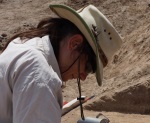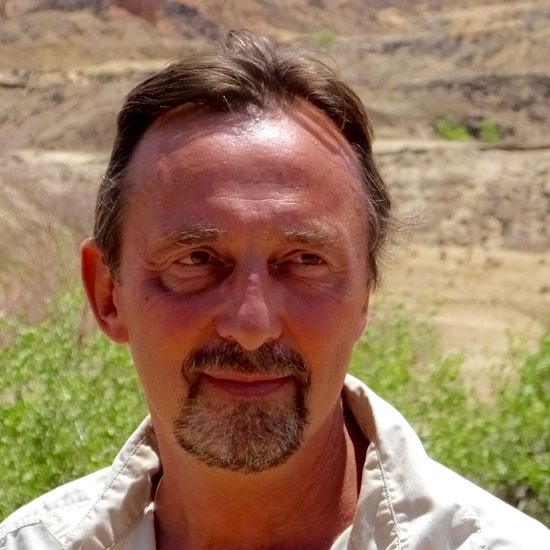Links to external sources may no longer work as intended. The content may not represent the latest thinking in this area or the Society’s current position on the topic.
Major transitions in human evolution

Scientific discussion meeting organised in partnership with the British Academy by Professor Robert Foley FBA, Professor Chris Stringer FRS, Dr Marta Mirazón Lahr and Professor Lawrence Martin
The rich human palaeoanthropological record shows an unexpectedly complex pattern in the tempo and mode of human evolution. Evidence for many of the key phases is found in East Africa, and has been shaped by critical discoveries by teams led by Richard Leakey, or work inspired by his finds. The meeting focussed on key evolutionary transitions to understand the interaction of biology, behaviour, culture and environment.
Papers related to this meeting have been published in Philosophical Transactions B.
Download the meeting programme (PDF).
Enquiries: Contact the events team
Schedule
Chair

Dr Hélène Roche, Université de Paris X, France

Dr Hélène Roche, Université de Paris X, France
Hélène Roche is Directeur de Recherche Emerite at the Centre National de la Recherche Scientifique. She led the Mission Préhistorique Française au Kenya and the West Turkana Archaeological Project (WTAP) until 2011, the goal of which was to document and interpret behavioural evolution of early hominids. Her field work has always been located in East Africa (mainly in Kenya) and her research activities are focused on the Early Palaeolithic and on the evolution of lithic technology, from its late Pliocene beginnings until the end of the Acheulean. Her approach to the technology of early hominins (Australopithecines and early Homo) reconstructs cognitive processes, evaluating the skill and knowledge of the prehistoric knapper. In West Turkana (Kenya), these early hominin technological activities are put into a well-defined chronological and palaeoenvironmental framework, in order to evaluate the impact of global and regional climatic changes on biological and cultural evolution.
| 09:05 - 09:25 |
Chronology of hominin discoveries in the Turkana Basin and their impact on understanding human evolution
Since the 1950s the East African Rift Valley has been one of the primary sources for evidence for human evolution. While early research focused on Olduvai and the central rift, from the late 1960s the Turkana Basin in Northern Kenya and Ethiopia has provided the richest and most diverse record of human evolution, stretching from the first australopithecines (A. anamensis at Lothagam) to the evolution of modern humans (Omo Kibish), to recent hunter-gatherers. It would be impossible to reconstruct human evolution without the contribution of the Turkana Basin hominins. This introduction looks at the chronology of discoveries across this period, and how specific discoveries by Richard and Meave Leakey changed ideas and models of hominin evolution at various points in the last fifty years, and discusses the key insights that the Turkana Basin hominins provide about the pattern of early hominin evolution. 
Professor Lawrence B. Martin, Stony Brook University, USA

Professor Lawrence B. Martin, Stony Brook University, USALawrence Martin serves as Director of the Turkana Basin Institute (2007-present), and Professor of Anthropology and of Anatomical Sciences at Stony Brook University. Martin is a physical anthropologist who studies the evolution of apes and the origin of humans. He conducted his doctoral research at the Natural History Museum in London and in 1983 received his Ph.D. in Anthropology from University College London, for which he received the Thomas Henry Huxley Award from the Zoological Society of London. Following a Medical Research Council Postdoctoral Research Training Fellowship in Anatomy and Embryology at UCL he joined the faculty at Stony Brook as an Assistant Professor in the Department of Anthropology, and later also in Anatomical Sciences. He served as Director of the Interdepartmental Doctoral Program in Anthropological Sciences before his appointment as Dean of the Graduate School in 1993, a position that he held until 2012. He additionally served as Director of International Programs from 1996 to 2003 and as Associate Provost from 2001 to 2012. |
|
|---|---|---|
| 09:25 - 09:50 |
Environments and mammalian communities in the East African Plio-Pleistocene: an ecometric analysis of the fossil mammal record of the Turkana Basin
Although ecometric methods have been used to analyse fossil mammal faunas and environments of Eurasia and North America, such methods have not yet been applied to the rich fossil mammal record of East Africa. Here we present the first results of ecometric analyses at two scales: continental and regional, and at two trophic levels: primary and secondary consumer. We discuss environments and evolutionary trends of the Turkana Basin Mio-Pleistocene mammal faunas in a broader setting of Eastern Africa and Western Eurasia, both in the light of our new results and in relation to previous work. We also show how the degree of aggregation affects the patterns recovered and discuss the implications of such scaling effects. 
Professor Mikael Fortelius, University of Helsinki, Finland

Professor Mikael Fortelius, University of Helsinki, FinlandMikael Fortelius is a palaeontologist with a long-standing interest in how mammalian teeth work, grow, and evolve, and how understanding teeth can help us understand the past, present, and future states of the world. He is Professor of Evolutionary Palaeontology in the Department of Geoscience and Geography at the University of Helsinki. For the last twenty years he has been engaged in developing and using the NOW database of fossil mammals. His past work has been strongly centred on the last twenty million years of climate change and mammal evolution in Eurasia. He has only recently become involved with research in Africa, where he is hoping to apply the 'ecometric' methodology developed for Eurasia during the last few decades. |
|
| 09:50 - 10:15 |
Kenyanthropus and hominin diversity in the middle Pliocene
For many years, most interpretations of early hominin phylogeny depicted a single lineage of Australopithecus afarensis throughout the middle Pliocene, which gave rise to a diverse radiation of taxa after 3.0 Ma. In 2001, the discovery at West Turkana, Kenya, of the 3.5 Ma old cranium of Kenyanthropus platyops, with a unique combination of derived facial and primitive neurocranial features that contrasted with the prognathic face of A. afarensis, provided the first convincing evidence that there was taxonomic diversity in the hominin record at this time. Subsequent and more detailed comparisons of K. platyops with a large sample of African Plio-Pleistocene hominin fossils, modern humans and great apes, using conventional and geometric morphometric methods together with high-resolution computed tomography, confirmed the unique morphology of Kenyanthropus. Recently, 3.4 Ma finds from Woranso-Mille, Ethiopia, have provided further evidence of hominin species diversity at this time, in the form of strongly contrasting foot morphology. Most recently, the earliest known stone tools, dating to 3.3 Ma, have been described from a locality in close proximity to that of Kenyanthropus, raising the question as to which hominin was the stone tool maker. A review, summarizing currently known evidence for Kenyanthropus in the context of these new finds, is therefore timely. 
Dr Meave Leakey, Turkana Basin Institute, Kenya and Stony Brook University, USA

Dr Meave Leakey, Turkana Basin Institute, Kenya and Stony Brook University, USAMeave Leakey is a Research Professor in the Department of Anthropology at the University of Stony Brook, New York, and Director of Plio-Pleistocene Research at the Turkana Basin Institute, Nairobi. In 2002, she was named a National Geographic ‘Explorer-in-Residence.’ Meave’s research activities are both field and lab based. The annual interdisciplinary field expeditions of the Koobi Fora Research Project (KFRP), to the Turkana Basin, northern Kenya, survey the badlands for fossil evidence of early human ancestors and their contemporary faunas. Over the past 45 years, the KFRP has discovered numerous new vertebrate species, including spectacular fossil hominin discoveries, which have enhanced the understanding of our own evolutionary past prior to the emergence of Homo sapiens. Together with colleagues, Meave has described new species of early apes, monkeys and human ancestors, including Australopithecus anamensis, the earliest known australopithecine, and Kenyanthropus platyops, which provides evidence of diversity in the human fossil record 3.5 million years ago. |
|
| 10:15 - 10:40 | Discussion | |
| 11:10 - 11:35 |
Australopithecus and the transition to early Homo
The age of origin of the Homo lineage is thought to have fallen in the time period between 2.5 and 3.0 Ma. The relevant fossil record in Africa is, however, notoriously poor, thwarting attempts to discern the pattern of earliest Homo evolution and delineate its proximate causes. Recent discoveries at Ledi-Geraru in the Afar rift of Ethiopia push the Homo lineage back to 2.8 Ma. Although separated in time from Australopithecus afarensis at the neighboring Hadar site by only two-hundred thousand years, these fossils show derived dental and gnathic traits and occur in a strikingly more open palaeoenvironmental setting. Coupled with new discoveries of very early flaked stone tools at West Turkana, Kenya, contemporary with small-brained australopiths at 3.3 Ma, the Ledi fossil hominins open the possibility of a new evaluation of factors involved in the transition to Homo. 
Professor William Kimbel, Arizona State University, USA

Professor William Kimbel, Arizona State University, USAWilliam H. Kimbel received his BA from Case Western Reserve University (1976) and his PhD from Kent State University (1986). He was Associate Curator and Head of Physical Anthropology at the Cleveland Museum of Natural History (1981-1985) before joining the Institute of Human Origins (IHO) in Berkeley, California. In 1997 IHO relocated to Arizona State University, where Kimbel is currently its Director and Virginia M. Ullman Professor of Natural History and the Environment in the School of Human Evolution and Social Change. Kimbel has conducted field and analytical research on Australopithecus and early Homo in Africa; Neandertals in the Middle East; the evolution of ape and human skull form and function; and the concepts of biological systematics as applied to paleoanthropological problems. Since 1990, he has co-directed research at the Hadar site in the Afar region of Ethiopia, which has produced more than 400 fossils of the hominin species Australopithecus afarensis between 3.4 and 3.0 Ma. Among his numerous publications, Kimbel is author (with Yoel Rak and Donald Johanson) of The Skull of Australopithecus afarensis (Oxford, 2004) and editor (with Lawrence Martin) of Species, Species Concepts and Primate Evolution (Plenum, 1993). He was Joint Editor of Journal of Human Evolution from 2003 to 2008. In 2005, Kimbel was elected Fellow of the American Association for the Advancement of Science. |
|
| 11:35 - 12:00 |
An earlier origin for stone tool making: implications for cognitive evolution and the transition to Homo
The discovery of the earliest known stone tools at Lomekwi 3 from West Turkana, Kenya, dated to 3.3 Ma, raises new questions about the mode and tempo of key adaptations in the hominin lineage. Conventionally, the origin of stone knapping was linked to the rise of the genus Homo, in response to climate change and the spread of savanna grasslands, a presumption that has remained strong until quite recently. The Lomekwi 3 tools date to before the earliest known fossils attributed to Homo at 2.8 Ma. They were made and deposited in a more wooded environment than were the earliest Oldowan tools at 2.6 Ma. Their discovery leads to renewed investigation on the timing of the emergence of human-like manipulative capabilities in early hominins and implications for reconstructing cognition. The Lomekwi 3 artefacts form part of an emerging paradigm shift in palaeoanthropology, in which: tool-use and tool-making behaviors are not necessarily limited to the genus Homo; cranial, post-cranial and behavioral diversity in early Homo is much wider than previously thought; and these evolutionary changes may not have been related to the opening of savanna grassland environments. 
Professor Sonia Harmand, Stony Brook University, USA and Turkana Basin Institute, Kenya

Professor Sonia Harmand, Stony Brook University, USA and Turkana Basin Institute, KenyaDr Harmand is currently a Professor at the University of Stony Brook and co-Director of the West Turkana Archaeological Project. Dr Harmand is an expert in Early Stone Age archaeology. Her research program revolves around the central theme of how, when and why did stone tool manufacture and use originate among hominins. Since 1998, she has focused her research on reconstructing the genesis of hominin technology, a period for which the archaeological record is meager. In 2011, her annual field expedition in northern Kenya yielded the earliest archaeological site known, dated at 3.3 million years. In addition, Professor Harmand is exploring with her team the biomechanics involved in the making and possible use of stone tools. She is also currently collaborating with primate archaeologists. Professor Harmand worked as a Research Scientist at the Centre National de la Recherche Scientifique (CNRS) in France from 2009 to 2012. |
|
| 12:00 - 12:30 | Discussion |
Chair

Professor Bernard Wood, George Washington University, USA

Professor Bernard Wood, George Washington University, USA
Bernard Wood is University Professor of Human Origins and director of the Center for the Advanced Study of Human Palaeobiology at George Washington University. While in medical school in England in 1968, he joined Richard Leakey's first Koobi Fora exploration and excavations at Lake Turkana, Kenya, and has done research in palaeoanthropology ever since. He is the author or co-author of 12 books that range from a 1991 major monograph on the hominid cranial remains from Koobi Fora to the non-technical Human Evolution, A Very Short Introduction. He edits the Wiley-Blackwell Encyclopedia of Human Evolution and is the author of over 200 refereed scientific articles and book chapters. His research interests are taxonomy, phylogeny reconstruction and comparative morphology. He is an honorary fellow of the Royal College of Surgeons of England.
| 13:30 - 13:55 |
Palaeovegetation from plant wax biomarkers in terrestrial and marine sediments
Carbon isotope ratios from plant wax biomarkers in sedimentary archives reflect the proportion of C¬3 and C4 vegetation in past ecosystems. Biomarkers in sediments from fossil sites in East Africa and from adjacent marine core sites have great potential for improving our understanding of the role of vegetation and ecological change in human evolution. We review existing Miocene to Pleistocene plant wax carbon isotope data from terrestrial and marine sediments in and around East Africa with specific focus on their contributions to understanding human evolution. An advantage of isotope records from fossil-bearing terrestrial sediments (e.g., palaeosols) is that they represent a local vegetation signal that directly reflects hominin environments, therefore enabling direct comparison between vegetation change and evolutionary events. As an example, we present palaeosol biomarker data from the Shungura Formation in Lower Omo Valley, Ethiopia that indicate an expansion of C4 vegetation at ca. 2.8 Ma. The vegetation shift directly precedes the appearance of Paranthropus aethiopicus, which had a C4-rich diet. Advantages of isotope records from deep-sea sediments are that they can detect vegetation changes driven by orbital cyclicity and that they preserve long-term records of change because of steady depositional rates over long timescales. Existing isotope data from Deep Sea Drilling Project Site 231 in the Gulf of Aden indicate an overall increases in C4 vegetation from the late Miocene to the Pleistocene. The Site 231 data suggest additional vegetation information can be obtained from other marine cores around East Africa. 
Dr Kevin Uno, Lamont-Doherty Earth Observatory of Columbia University, USA

Dr Kevin Uno, Lamont-Doherty Earth Observatory of Columbia University, USAKevin Uno is a geochemist whose primary research focus is aimed at understanding the effects of climate change and biotic interactions on mammalian evolution. He uses stable isotopes in molecular biomarkers, fossil teeth, and soil carbonates to study climate and biota in the geologic past. Measuring carbon isotope ratios in teeth has enabled him to evaluate the response of mammalian diets to ecological change during the late Neogene period in East Africa. He has developed methods to use isotopes from fossil elephant molars and tusks as archives of seasonality in ancient ecosystems. He is currently working on using leaf waxes and other molecular biomarkers in sediments to reconstruct vegetation and hydroclimate in ancient terrestrial ecosystems in East Africa and North America. He is also interested in wildlife forensics, where he uses bomb-curve radiocarbon to determine the age of elephant ivory and other wildlife tissues. The age of the ivory determines whether trade is legal and can also be used to understand how illegal trade networks operate. |
|
|---|---|---|
| 13:55 - 14:20 |
The evolution of body size and shape in the human career
It is widely recognized that body size is a fundamental biological property of organisms, and documenting body size variation in hominin evolution appears to be an important and tractable goal of palaeoanthropology. Is there an inexorable increase in body size in human evolution? Are we another example of “Cope’s Law”? Is an increase in body size linked to the emergence of the genus Homo as some suggest? Is the evolution of hominin body shape predicted by changes in body size? Estimating body size (=mass) appears deceptively simple, but it is laden with theoretical and pragmatic assumptions about “best predictors” and the most appropriate reference samples. Modern human “training samples” are favored for estimating size in early bipedal hominins like the australopiths, but are these the most appropriate for the earliest putative hominins like Ororrin and Ardipithecus? The trajectory of body size evolution in the human career is reviewed here and found to be complex and nonlinear. Body mass estimates for the Late Miocene hominins suggest that some are just as large as some australopiths, and australopiths vary enormously and overlap extensively with Homo erectus. The pre-erectus early Homo fossil record is poor, but these earliest members of our genus appear relatively small-bodied, as do the earliest member of our genus found outside of Africa. Large body size is therefore not a hallmark of the genus Homo. Body size evolution alone cannot explain the observed variation in body shape, especially when examined in the context of the smallest known fossil hominins and small-bodied modern humans (pygmies). 
Professor William Jungers, Stony Brook University, USA

Professor William Jungers, Stony Brook University, USAWilliam Jungers is a Distinguished Teaching Professor in the Department of Anatomical Sciences and the Interdepartmental Doctoral Program in Anthropological Sciences at Stony Brook University. Educated at Oberlin College and the University of Michigan, his research interests include paleoanthropology, functional anatomy and morphometrics, with a focus on the evolution of body size and shape. He is a former editor of The Journal of Human Evolution, and has conducted paleontological field work in Madagascar (giant extinct lemurs) and Indonesia (Homo floresiensis). He is involved in collaborative research projects on Ardipithecus ramidus postcrania and reconstructing body size in the earliest hominins; he is currently analyzing new fossils of early Homo from Ileret in Kenya (with Meave Leakey and the Turkana Basin Institute). He recently published (2014) Extinct Madagascar: Picturing the Island’s Past (with Steve Goodman). |
|
| 14:20 - 14:45 |
Measures of maturation in early fossil hominins
The earliest hominins were bipedal, had reduced canine size and some had bigger brains than living great apes. All this suggests a way of life that in many ways differed from great apes today. Evidence for the pace of growth in early hominins comes from preserved tooth microstructure. A record of incremental growth in enamel and dentine persists that allows us to reconstruct tooth growth and compare key measures of dental maturation with modern humans and living great apes. An important question is whether, among the first fossils attributed to early Homo, there was shift towards a more prolonged period of development and whether there was a slow modern human-like period of growth between the end of weaning and the beginning of puberty. If, despite their different way of life and diverse diets, these aspects of early hominin development were indistinguishable from either earlier australopiths and/or from living great apes then this must be interpreted in the context of their life history biology. 
Professor Christopher Dean, University College London, UK

Professor Christopher Dean, University College London, UKChristopher Dean is currently professor of anatomy at University College London, within the Department of Cell and Developmental Biology at UCL. Christopher Dean studied dental surgery (London) then human biology (Oxford) before obtaining his PhD in 1983 from The Middlesex Hospital Medical School, London. His research interests are focused on palaeoanthropology and include the comparative microanatomy of primate dental hard tissues and their usefulness in establishing measures of maturation in early hominins and the comparative anatomy of the hominid cranial base. Christopher Dean has co-authored two textbooks, Introduction to Evolutionary Anatomy, with Leslie Aiello (1990), and Core Anatomy for Students with John Pegington (1995) and has published extensively on topics related to his research. |
|
| 14:45 - 15:10 | Discussion | |
| 15:40 - 16:05 |
Does morphological variation in Homo erectus signal the origins of developmental plasticity?
Homo erectus was the first hominin to exhibit extensive range expansion. This extraordinary departure from Africa, especially into the temperate climates of Eurasia, has been variously related to technological, energetic and foraging shifts. Recent discoveries highlight both temporal and regional anatomical variation in H. erectus suggesting the possibility that developmental plasticity, a key factor in H. sapiens ability to occupy a variety of habitats, may have been present in H. erectus. Here we use measures of morphological variation to consider whether the origin of developmental plasticity played a role in H. erectus’ dispersal success. Developmental plasticity, the ability to modify development in response to environmental conditions, results in differences in size, shape and dimorphism across human populations that relate in part to levels of resource sufficiency and extrinsic mortality. These differences predict that the skeletal record should show not only regional variation, but overall smaller adult sizes and lower levels of dimorphism in instances of resource scarcity and high predator load. We review metadata for recent humans. And we compare cranial and postcranial shape and size variation and dimorphism among skeletal ‘populations’ of H. erectus, H. sapiens and exemplar nonhuman primates from known environmental contexts. Developmental plasticity in H. erectus is suggested by some of these measures. We discuss the implications of the pattern of conflicting signals across our sample for inferring plasticity, make recommendations for differential use based on the fidelity of different variables in the extant record, and argue that differences in dimorphism among regional samples should be interpreted as evidence of plasticity. 
Professor Susan Antón, New York University, USA

Professor Susan Antón, New York University, USASusan Antón is a professor in the Center for the Study of Human Origins, director of the MA program in Human Skeletal Biology, and Chair of the Department of Anthropology at New York University. Her field research concerns the evolution of genus Homo in Indonesia and human influence on island ecosystems in the South Pacific. She is a member of the Koobi Fora Research Project led by Meave and Louise Leakey. And she is co-founder of the Bones and Behavior (bonesandbehavior.org) group, which aims to understand adaptation in marginal environments. Much of her work focuses on the origin and dispersal of the genus Homo, especially H. erectus in Kenya and Indonesia, for which she was elected as a fellow of the American Association for the Advancement of Science (AAAS). In addition to her research, Susan has received numerous teaching awards, including the Distinguished Teaching Medal from NYU. She is the current President of the American Association of Physical Anthropologists and past editor of the Journal of Human Evolution. |
|
| 16:30 - 17:00 | Discussion | |
| 16:05 - 16:30 |
The evolution of more complex technology: current perspectives on the origins of the Acheulean
In recent years, research in the emergence of the Acheulean has attracted considerable interest. This has resulted in a wealth of new data on the earliest age of the Acheulean, its initial dispersion, palaeoecological context, technological features, and human species associated with this technology. Currently available evidence suggests that the Acheulean emerged 1.78 million years ago in East Africa, and quickly radiated to other areas of Africa and beyond. However, the hard evidence alone does not explain the evolutionary and cultural mechanisms that triggered the transition to the Acheulean, and a discussion of the contributing factors – cultural, biological and palaeoecological – is needed. With an emphasis on the East African record, this paper will review the state of the art in Acheulean origins research, and contextualize the archaeological evidence and existing paradigms used to interpret the emergence and dispersion of the Acheulean and the eventual disappearance of the Oldowan. 
Ignacio de la Torre

Ignacio de la Torre |
Chair

Professor Mark Thomas, University College London, UK

Professor Mark Thomas, University College London, UK
Mark Thomas has worked extensively on understanding how humans have evolved and migrated around the world. He has used genetic data – including ancient DNA – computer simulations and archaeological information to examine the origins and past migrations of a number of specific human populations including Jewish and Judaic groups, British populations and a number of enigmatic European and African peoples. In recent years he has worked on using 14C data as a proxy for past demography, on modelling cultural evolution to better understand the origins of modern human behaviour, and to examine ethnic structuring in past populations, on recent natural selection using genetic data – particularly in relation to diet and infectious disease – and on gene-culture co-evolution, particularly the origins of lactase persistence and dairying in Europe and Africa.
| 09:00 - 09:25 |
The origin of Homo sapiens
If we restrict the use of Homo sapiens in the fossil record to specimens which share a significant number of synapomorphies in the skeleton with extant Homo sapiens, the origin of our species would be placed in the African late Middle Pleistocene, based on fossils such as Omo Kibish 1, Herto 1 and 2, and the Levantine material from Skhul and Qafzeh. However, genetic data suggest that we and our sister species Homo neanderthalensis shared a last common ancestor in the middle part of the Middle Pleistocene ~400ka, which is some 200,000 years earlier than the species origin indicated from the fossils already mentioned. Thus it is likely that the African fossil record will document early members of the sapiens lineage showing only some of the synapomorphies of late members of the lineage. On that basis, I argue that human fossils such as those from Jebel Irhoud, Florisbad, Eliye Springs and Omo Kibish 2 do represent early members of the species, but variation across the African later Middle Pleistocene/early Middle Stone Age fossils shows that there was not a simple linear progression towards later sapiens morphology, and there was chronological overlap between different ‘archaic’ and ‘modern’ morphs. Even in the late Pleistocene of Africa and beyond we can find specimens which are clearly outside the range of Holocene Homo sapiens, showing the complexity of recent human evolution.

Professor Chris Stringer FRS, Natural History Museum, UK

Professor Chris Stringer FRS, Natural History Museum, UKProfessor Chris Stringer has worked at the Natural History Museum since 1973, and is now Research Leader in Human Origins and a Fellow of the Royal Society. His early research concentrated on the relationship of Neanderthals and early modern humans in Europe, but through his work on the 'Recent African Origin' model, he now collaborates with archaeologists, dating specialists and geneticists in attempting to reconstruct the evolution of modern humans globally. He has excavated at sites in Britain and abroad, directed the Ancient Human Occupation of Britain project (AHOB) for 13 years, and now co-directs the Pathways to Ancient Britain project (PAB). His recent books include The Origin of our Species (published in the USA as Lone Survivors, 2013) and Britain: one million years of the human story (with Rob Dinnis, 2014). |
|
|---|---|---|
| 09:25 - 09:50 |
The shaping of human diversity: filters, boundaries and transitions
How human diversity evolved remains a fascinating and dynamic research field. Different processes – cultural and biological - acted to shape the evolution of different populations in time and space, creating a complex palimpsest of similarities and differences. The outcome of this process, at times accelerated by sharp demographic and geographical fluctuations, is that the population ancestral to all humans did not look or behave like any alive today. This has generated major questions regarding the evolution of human universal characters, as well as the nature and timing of major evolutionary events in the history of the species. The paucity of African fossils remains a major stumbling block for exploring some of these issues. However, major breakthroughs from genomics and palaeogenomics have revealed aspects of the demography of late Quaternary hominin groups and their interactions, as well as those between foragers and farmers. The latter have been critical in shaping the last 10,000 years, in what I have named the Holocene Filter, the mechanism by which human diversity throughout the world decreased as a consequence of the differential expansion of a few populations. However, there are other key moments in the history of our species – ‘filters’, during which extinction would have been a major factor, and ‘transitions’, during which population growth enhances and exports evolutionary novelties, creating novel conditions for human biological adaptation and accumulated culture. This paper explores the nature and timing of these key moments in evolution of human diversity. 
Dr Marta Mirazón Lahr, University of Cambridge, UK

Dr Marta Mirazón Lahr, University of Cambridge, UKMarta Mirazon Lahr, a Fellow of Clare College, is a Reader in Human Evolutionary Biology and Director of the Duckworth Collection at the University of Cambridge, where she and Robert Foley founded the Leverhulme Centre for Human Evolutionary Studies. The focus of her research is the evolution and diversity of our species, Homo sapiens. Her work involves a range of disciplines - human palaeontology, evolutionary genetics, behavioural ecology, linguistics and prehistoric archaeology. She has carried out fieldwork in the Amazon, the South Pacific, India, Oman, Libya and Kenya. She is the director of the IN-AFRICA Project in Kenya, and a co-investigator in the Trans-Sahara Project, and the African Genomes Project with the GeoGenetics Centre of Copenhagen. |
|
| 09:50 - 10:15 |
Ancient human genomics: new approaches to human dispersals and population history
Ancient DNA research on human remains have recently moved from the sequencing of short fragments of mitochondrial DNA mired with contamination to that of full genomes. This transition means that contamination levels can be probably quantified and that it has become possible testing complex scenarios of human population histories not revivable from uni-parentally inherited markers alone. Recent discoveries includes that Native Americans thought to be of east Asian origin also shares recent ancestry with western Eurasians through a Upper Palaeolithic population in central Asia, that populations of early anatomically modern humans in Europe were structured, contained longer tracks of neanderthal DNA and diversified from east Asians more than 37 thousand years ago. Ancient human genomics have also revealed that Aboriginal Australian ancestors diversified some 20-30 thousand years earlier from the African stuck than did eurasians. Ancient human genomics have also showed that the New World Arctic was populated twice and that significant cultural changes not always is associated with population movement, but can happen simply from the spread of ideas within a population and that peoples of the Clovis culture in North America are the direct ancestors of many contemporary Native Americans and are not closer related to Europeans or Asians. As such past genomics is transforming our view of human history and is likely to do so for the years to come. 
Professor Eske Willerslev, University of Copenhagen, Denmark

Professor Eske Willerslev, University of Copenhagen, DenmarkEske Willerslev is a Lundbeck Foundation Professor at University of Copenhagen and is The Prince Philip Professorship of Ecology and Evolutionary Biology elect at University of Cambridge. He is director of the Centre of Excellence at Centre for GeoGenetics and the Danish National CryoBank and Sequencing Facility. Willerslev is an evolutionary geneticist recognized for his studies on human dispersal, microbial long-term survival and evolution, megafaunal extinctions, DNA degradation, and environmental DNA. He is particularly known for sequencing the first ancient human genome, conducting the first large-scale multi-species ancient population genetic study, and establishing the field of environmental DNA, where modern and ancient DNA from organisms such as higher plants and animals are obtained directly from environmental samples such as sediments, ice and water. Willerslev has been visiting researcher at the MD Anderson Cancer Research Centre in Austin, Texas, and independent Welcome Trust Fellow at Oxford. He is Honorary Doctor at University of Oslo and has been Visiting Professor at Oxford University and Visiting Miller Professor at UC Berkeley. |
|
| 10:15 - 10:40 | Discussion | |
| 11:10 - 11:35 |
The Middle-Later Stone Age transition in East Africa
The appearance of Later Stone Age (LSA) technologies in Africa represents a major change in the archaeological record, in which technologies, subsistence strategies, and patterns of socio-territorial organization closely resemble those seen in recent and historical foraging societies. There are sharp discontinuities between the earliest LSA and latest Middle Stone Age (MSA) strata at many sites in southern, western, and northern Africa. This pattern may simply be an artifact of the nature of the record of sediment preservation, or a signal of the periodic abandonment of these regions by early modern human populations. In contrast, East Africa preserves a number of more-or-less continuous sequences across the MSA-LSA transition, and these preserve evidence for a complex and perhaps prolonged process of change, a pattern that might reflect a more continuous record of occupation in the area throughout Late Pleistocene climatic variations. In addition to examining temporal variation across the MSA-LSA transition in East Africa, we use lithic and palaeoenvironmental (faunal) data from a longitudinal transect of LSA sites from the Last Glacial Maximum and Late Glacial to explore relationships between the environment and human behaviour that likely structures the archaeological record and the nature of the appearance in LSA technologies. We observe longitudinal gradients in past faunal community composition that parallel contemporary environmental gradients in East Africa. This is associated with longitudinal variation in the frequency of microliths (the defining LSA artifact type) from archaeological sites, a pattern we interpret as a response to variable environmental risk across space. Spatial and temporal variability in Pleistocene habitats may therefore play a key role in structuring the complex appearance of LSA technologies across Africa. 
Dr Christian Tryon, Harvard University, USA

Dr Christian Tryon, Harvard University, USADr Tryon is a Paleolithic archaeologist who focuses on the origin, diversity, and dispersal of modern humans in Middle and Late Pleistocene Africa, with an emphasis on lithic technology, chronology, and paleoenvironmental context. He received his Ph.D. in 2003 from the University of Connecticut, has held postdoctoral positions through the Fyssen Foundation and the Smithsonian Institution’s National Museum of Natural History, and taught at the George Washington University and New York University before joining the faculty at Harvard in 2013. He co-directs a number of field- and museum-based projects in Kenya and Tanzania, and has previously worked on sites in Turkey, France, and the US. He lives in Cambridge, Massachusetts with his wife Rhonda and daughter Violet. |
|
| 11:35 - 12:00 |
Surround, defend, and advance: how the transition to foraging for dense and predictable resources changed the course of human evolution
The three key evolved features of human uniqueness are a highly advanced cognition, hyper-prosocial proclivities, and a dependence on social learning. These provide the capacity for cumulative culture that is so fundamental to the modern human niche. Hyper-prosociality is the tendency for regular cooperation with un-related individuals without the expectation of immediate pay-offs, and can entail a cost to the cooperator. The regularity and extent of this cooperation among humans is unique among living animals, and thus it is crucial to identify when this feature evolved in the hominin lineage. Explaining the evolution of hyper-prosociality is challenging since Neo-Darwinian theory fails at the task. Models that rest on multi-level selection in a cultural species appear more powerful, and those that identify inter-group conflict as providing the key selective context are persuasive. Here it is hypothesized that the conditions for inter-cultural-group conflict developed in the Middle Stone Age among early modern humans and provided the selective context for hyper-prosociality. This occurred when early modern humans first began exploiting dense and predictable food resources, escaping a dietary pattern of foraging for sparse, unpredictable resources exploited with a high mobility strategy. The first evidence for this transition, dating to ~160,000 years ago at Pinnacle Point, is in a coastal inter-tidal context in southern Africa. When these coastal adaptations matured, territorial defence was triggered, as predicted by the theory of economic defendability. This conflict may have led to our highly cooperative species and prepared it to colonize the world and displace all other hominin species. 
Professor Curtis Marean, Arizona State University, USA

Professor Curtis Marean, Arizona State University, USACurtis W. Marean (Ph.D. University of California at Berkeley 1990; Professor in the School of Human Evolution and Social Change, Arizona State University and associate director of the Institute of Human Origins) has research interests on the origins of modern humans, the prehistory of Africa, paleoclimates and paleoenvironments, and the study of animal bones from archaeological sites. He is particularly interested in human occupation of coastal and grassland ecosystems. He has conducted research in Kenya, Tanzania, and Somalia, and since 1991 has been conducting field research in coastal South Africa. He is the principal investigator for the South African Coast Paleoclimate, Paleoenvironment, Paleoecology, Paleoanthropology (SACP4) project based near Mossel Bay. |
|
| 12:00 - 12:30 | Discussion |
Chair

Professor Clive Gamble FBA, University of Southampton, UK

Professor Clive Gamble FBA, University of Southampton, UK
Clive Gamble is a Fellow of the British Academy and Professor in the Centre for the Archaeology of Human Origins in the Faculty of Humanities, University of Southampton. His recent projects include the British Academy’s Centenary Project ‘From Lucy to language: the archaeology of the social brain’ (2004-2011) which brought together archaeologists and psychologists to study when hominin brains became human minds. This is the subject of his two most recent books ‘Settling the Earth: the archaeology of deep human history’ (2013) and ‘Thinking big: how the evolution of social life shaped the human mind’ (2014 with John Gowlett and Robin Dunbar). He is currently leading two major projects funded by the AHRC and Leverhulme Trust; the first examines thresholds in hominin behaviour at the site of La Cotte de St Brelade, Jersey, and the second the beginnings of food storage in the late Pleistocene of Europe.
| 13:30 - 13:55 |
Reconciling terrestrial and marine records of African climate change
Terrestrial and marine sediment archives in and around East Africa place new constraints on the timing and magnitude of regional climate changes during the late Neogene. These records collectively document a progressive increase in C4 vegetation over the last 3-4 Ma suggesting a shift to more open conditions. They also document the importance of orbital-scale palaeohydrology and vegetation changes paced by precessional forcing of monsoonal circulation. Syntheses of terrestrial soil carbonate d13C records have shown strong regional differences in vegetation change. Here, we compile marine and terrestrial stable isotopic records to explore the relative amplitudes of orbital-scale versus longer-term secular changes in East African climate and vegetation over the late Neogene. This approach exploits the proxy-specific recording biases inherent to soil carbonate, tooth enamel, and molecular biomarker records and the sediment archive. We attempt test the hypothesis that orbital-scale palaeohydrological and vegetation shifts were as large, or larger, than the long term secular trends. This study strives to understand the magnitudes of rainfall and vegetation variability ‘on the ground’ that occurred within and across individual hominid linage ranges. 
Professor Peter de Menocal, Lamont-Doherty Earth Observatory of Columbia University, USA

Professor Peter de Menocal, Lamont-Doherty Earth Observatory of Columbia University, USAPeter B. de Menocal is a Professor and Vice Chair in the Department of Earth and Environmental Sciences at Columbia University. At Lamont-Doherty Earth Observatory, he uses geochemical analyses of ocean sediments to understand past changes in tropical ocean temperatures and terrestrial climate with a special interest in African paleoclimate change and its influence on human evolution and culture. He was awarded the Lenfest Columbia Distinguished Faculty award in 2008, the Distinguished Brooksian award in 2013, and is a Fellow of the American Geophysical Union. He was presented with an honorary D. Sci. from St. Lawrence University (2009). His currently leading the new Center for Climate and Life that seeks to understand how climate change impacts the security of food, water, shelter, and to explore sustainable energy solutions. |
|
|---|---|---|
| 13:55 - 14:20 |
Changing perspectives on the evolution of hominin culture
Over the last 25 years the study of the evolution of hominin culture has been transformed by three developments: 1) a dramatic increase in archaeological fieldwork, especially in Africa, 2) a surge of experimental and observational research on cultural behaviour in nonhuman animals and, 3) the development of a body of theory and supporting empirical work in which culture is conceptualised as an evolutionary system that interacts with, but is distinct from, the genetic system. In this paper, I will review these developments and discuss their implications for our understanding of the evolution of cultural behaviour in the hominin lineage, paying particular attention to the major transitions identified by previous generations of researchers. I will show that there is still evidence that a number of major transitions occurred in the course of hominin cultural evolution, but they differ substantially from those recognized in the past in terms of their nature and/or their timing. I will finish by highlighting some of the questions about the evolution of hominin culture that I think need to be addressed as a matter of priority. 
Professor Mark Collard, Simon Fraser University, Canada

Professor Mark Collard, Simon Fraser University, CanadaMark Collard is Canada Research Chair in Human Evolutionary Studies, Professor of Archaeology, and director of the Human Evolutionary Studies Program at Simon Fraser University in British Columbia, Canada. He also holds a personal chair in the Department of Archaeology at the University of Aberdeen. Professor Collard earned a BA in Archaeology and Prehistory from the University of Sheffield, and a PhD in Hominid Palaeontology from the University of Liverpool. After his PhD, Professor Collard held a Wellcome Trust Postdoctoral Fellowship in University College London’s Department of Anthropology. This was followed by faculty positions at University College London, Washington State University, and the University of British Columbia. He has been at Simon Fraser University since 2007. Professor Collard has published on a wide range of topics in Archaeology and Anthropology, but much of his work in recent years has involved the application of methods and theory from evolutionary biology to cultural data. |
|
| 14:20 - 14:45 |
Tempo and mode in human evolution: the problem of transitions
Biologists have long recognised that variation in the rates of evolution provides significant insights into the evolutionary process, both generally and for particular lineages. While the heat has gone out of the debate over two extremes, of gradualism and punctuated equilibrium, it remains the case that change is not spread evenly across the evolution of any lineage. The same is true for human evolution. However, for human evolution, not only do we have a solid fossil record, there is also direct and temporally-spatially fixed behavioural information from the archaeological record, and increasingly evidence from aDNA on the more recent phases. This allows us – uniquely for any lineage – to look at behaviour, phenotype and genetics to explore the relative positioning and significance of changes in any transitions that may have occurred. This paper explores this diversity of evidence to test the hypotheses that there were major evolutionary transitions in human evolution, when they occurred and the processes involved, and the relative roles of climate, environment and competition. Analytical units and events are: the radiation of the australopithecines in the Plio-Pleistocene, evolution of the genus Homo (3 – 2 Ma), the development of Homo erectus and allies (2 – 1 Ma), and the evolution of Homo sapiens (0.5 - 0 Ma). The conclusions will be used to consider a) the nature of speciation, extinction and diversity in hominin evolution; b) the role of behaviour in the evolutionary process. 
Professor Robert Foley FBA, University of Cambridge, UK

Professor Robert Foley FBA, University of Cambridge, UKRobert Foley is the Leverhulme Professor of Human Evolution at the University of Cambridge, a Fellow of King’s College, and a Fellow of the British Academy. He is a co-founder, with Marta Mirazón Lahr, of the Leverhulme Centre of Human Evolutionary Studies at Cambridge, an inter-disciplinary research centre. His research has focused on the ecological basis of human evolution and behaviour, and in particular the application of Darwinian models to patterns and processes of human evolution, ranging from the early hominins to recent human populations. He has worked extensively in East Africa, and carried out fieldwork in other parts of Africa and Melanesia. |
|
| 14:45 - 15:10 | Discussion | |
| 15:35 - 16:10 |
Closing remarks

Professor Richard Leakey FRS, Turkana Basin Institute, Kenya

Professor Richard Leakey FRS, Turkana Basin Institute, KenyaRichard Leakey, a Kenyan, has had a variety of careers. From 1968 through 1999 he built up Kenya’s National Museums and at the same time led an international research effort studying human evolution within the Turkana Basin in northern Kenya. After this he established the Kenya Wildlife Service and spear headed efforts to stem the slaughter of elephants for their ivory. From Conservation he went into Kenya’s politics, briefly sat in Kenya’s Parliament and later became the Head of Kenya’s Civil Service and Secretary to the Cabinet. After two years, he resigned and accepted a position as Professor of Anthropology at Stony Brook University. Over the past ten years from that position he has developed the now widely recognized Turkana Basin Institute as a global center of excellence for the study of human origins, vertebrate paleontology and related education opportunities for students. |
|
| 16:10 - 17:00 | Discussion |
